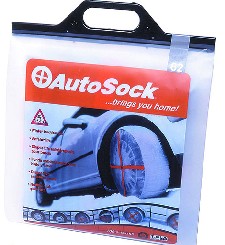Are
snow socks for tyres a low cost alternative to winter tyres
or snow chains?
AutoSock was launched in Norway in 2002 after a long period
of testing, evaluation and improvement. Sales have grown exponentially,
with over 330,000 pairs sold around Europe last winter, mostly
on recommendation. See the AutoSock video which shows just how
easy they are to fit. More
See the Which? magazine review on snow socks. More
See our earlier winter tyres NEWS item. More
Snow socks are
only a "get you home" measure not a substitute for
winter tyres
Chris Hunt Cooke recalled having seen rally competitors using
snow socks and noted "I have previously taken part in the
Le Jog (Lands End to John O'Groats) classic car rally and my
then navigator did it this year in a Mini. He reports that those
using Snow Socks found they disintegrated very quickly on dry
roads so were not a great help in changeable conditions. In
contrast the winner sailed through any adversity using Vredestein
winter tyres.

Photo: HERO Club website
Updated: 16.12.10
Posted: 5.12.10
Back
to homepage |


|
AutoSock
is a simple, effective, low cost way of getting
traction on snow and ice. It's achieved with the
AutoSock tyre cover fabric technology. AutoSock
textile tyre covers just slip over the driving wheels
when you find yourself getting stuck. They work
well in wet snow conditions so are particularly
appropriate for the UK where snowfall is sporadic
and few people use winter tyres.
Are snow socks for tyres the latest winter must-have?
The UK consumer group Which? reviewed snow socks
at the end of November 2010 and said “at £50
a pair, snow socks are certainly a cheap alternative
to buying and fitting a set of winter tyres and
rims. They should only be used for the odd occasion
when conditions really justify it.” See the
Which?
review |
|
Gavin
Bailey commented on the V8BB "I bought a set of snow
socks last winter. They proved useful in the snow and
are certainly effective, however they are more of a 'get
you home' or emergency solution rather than something
you would use on a regular basis. They are fairly easy
to fit and self-centre on the tyres once fitted, providing
plenty of traction on snow or slush. I used them on the
rear driving wheels of a BMW 5 Series Touring and they
helped me gain drive in conditons which would otherwise
rendered the car immobile. They also pack away neatly
into the supplied bag when not in use. The downsides are
they will wear very quickly if used on tarmac or in conditions
where the snow/slush is punctuated by stretches of tarmac.
The top speed you can do with them fitted is probably
around 30mph, however that's more than fast enough in
snow anyway. They are however a pain to pack away when
dirty and covered in slush/grit and you may need to stop
to fit/refit them a number of times over the course of
a journey subject to snow.
As a more permanent proposition, proper winter tyres with
a snow marking are much better but more costly. I've just
bought a set for a couple of cars and found they're in
short supply in the UK at present. My first set came from
Germany and the second set are on backorder. As I will
be using winter tyres from now on from October to the
end of March, I've bought a spare set of rims for each
car so that I can change the sets of tyres over when necessary.
Gavin added he had bought a set of winter wheels for a
car he "will be doing the daily commute in - around
100 miles/day round the M25 with early/cold starts in
the morning. Not worth taking a chance plus I can't afford
not to be in because the roads are icy or there's a bit
of snow around. Of
course havoc caused by other cars running standard tyres
in winter is another matter! But I mustn't be too hard
- that was me last year and the vast majority of motorists
in the UK!" (6.12.10) |
|

